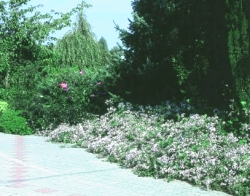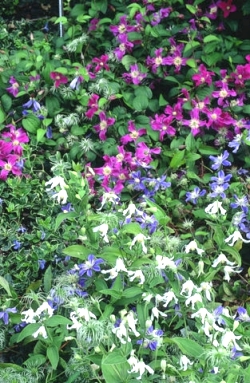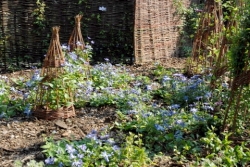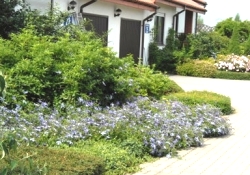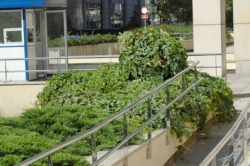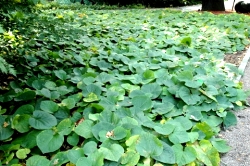Ground covers
 Ground covers can successfully substitute lawn, create borders or provide greenery beneath taller plants. They hinder the weed growth and prevent the soil from being blown or washed away, or getting too dry.
Ground covers can successfully substitute lawn, create borders or provide greenery beneath taller plants. They hinder the weed growth and prevent the soil from being blown or washed away, or getting too dry.
They also reduce costly and time-consuming maintenance while adding aesthetic value to the garden. Carefully selected plants according to the location, aspect, the size of the area to cover and the vigorousness of the neighbouring plants will produce the best results.
Both climbers, which are vigorous in habit and grow just as well on the ground if not given a support, and slower growing dwarf shrubs make excellent ground cover. They are resistant and undemanding and will adorn your garden with masses of foliage and/or flowers. There exist ground covers for any possible location: for semi-shade or even shade (e.g. ivy, Euonymus Fortunei, Climbing Hydrangea, Schizophragma or Vinca minor), a dwarf shrub that isn't a climber), and shady areas are often a landscaping challenge. You'll also find ground covers that will do well in a sunny, slightly drying location (e.g. Clematis from the Tangutica Group).
- species and cultivars
- planting
- culture
- frost hardiness zones
- overall table
|
Clematis 'Praecox' from the Heracleifolia Group is the best ground cover clematis. It's a cross between (Clematis vitalba) and (Clematis tubulosa) (which is very similar to (Clematis heracleifolia)). The stems spread over the ground growing up to 3-4m long annually and in just a few weeks engulf the area with a thick carpet of foliage that smothers the weeds and prevents the soil from drying and overheating. Three-lobed, toothed, dark green leaves. Bunches of small (3-4 cm in diameter) beige-violet flowers cover the plant in July and August. Sufficiently hardy for a cool climate, like the Polish one. Depending on the area it's supposed to cover, you should either prune it hard or light. When the space you cover is quite small, it's better to use less vigorous 'Mrs Robert Brydon', which grows up to 2 m annually, has pale violet flowers and dark green glossy leaves that are bigger than those of 'Praecox'.
If the area to cover is relatively small, you can also use other herbaceous clematis, especially from the Integrifolia Group (e.g. Clematis 'Arabella' (1994), 'Alionushka', 'Sizaia Ptitsa' or 'Pamiat Serdtsa') and they will cover it with a colourful carpet of flowers.
If the area is a bit bigger, other clematis, such as the Artagene Group, the Vitalba Group, the Viticella Group or the Tangutica Group (the latter are especially recommendable for a sunny site), will do very well.
- Clematis - Atragene Group. Cultivars derived from mountain species blooming between April and June on old wood (e.g. C. alpina or C. macropetala). The stems grow up to 2-3m and when left without support they spread over the ground and climb up the surrounding shrubs and trees. At the end of April and the beginning of May they turn into a colourful carpet of flowers: blue - 'Pamela Jackman', 'Lagoon', 'Frankie', 'Maidwall Hall'; violet - 'Jan Lindmark', 'Cecile', 'Blue Bird', 'Frances Rivis'; pink - 'Willy', 'Markham's Pink', 'Jacqueline du Pré', 'Constance', 'Ruby'; or white - sibirica, 'White Swan', 'Riga', 'Albina Plena'. The flowers turn into fluffy seed heads later in the season. All the plants are undemanding and resistant, but they don't like dry and acid soil. They can be used either in semi-shade or sun. Prune only when needed, after the flowering period has ended.
- Clematis - the Vitalba Group. 'Paul Farges' (SUMMER SNOW) is one of the most valuable cultivars from the group. It's vigorous, undemanding, healthy and very hardy. It will tolerate various types of soil and site. Prune in spring either hard (20-40cm from the base), or moderately (100-150cm from the base) depending on the need and the area available.
- Clematis - the Viticella Group. This group comprises summer-flowering clematis that bloom very profusely and over a long period. They are generally healthy and resistant, and do well in mediocre soil. When left without support, they sprawl over the ground forming colourful carpets. The following cultivars are particularly valuable: blue - 'Emilia Plater' and 'Prince Charles'; violet 'Etoile Violette' and 'Polish Spirit', red 'Mme Julia Correvon' i 'Kermesina' and lilac-pink 'Solina'. Prune hard every spring, 20-40cm from the base.
- Clematis - the Tangutica Group. Yellow-flowered clematis derived from C. tangutica and C. orientalis, free-flowering from June to October. Grow them without support to produce carpets of ground cover. 'Lambton Park', 'Bill MacKenzie' and 'Aureolin' are particularly valuable. They thrive in a sunny site. Hardy and undemanding, they will tolerate drying, poor soil, but don't like compact, waterlogged soil, so good draining is essential. Best pruned hard in March - April, 10-40 cm from the base.
Many plants grown as climbers can also be used as ground cover, e.g. Euonymus fortunei ('Coloratus' is its most appropriate cultivar for covering large areas - it's vigorous, resistant and undemanding), Ivy, Climbing Hydrangea, Japanese Hydrangea Vine and Virginia Creeper (especially for large areas). In a milder climate, for instance a sheltered spot in western, southern or central Poland, you can use Lonicera japonica 'Aureoreticulata' (yellow-green leaves) and 'Halliana' (free-flowering over a long period, fragrant), or Five-Leaf Akebia.
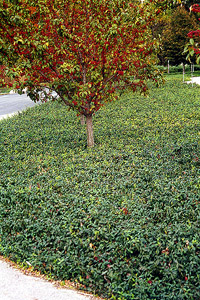 Euonymus fotunei 'Coloratus' |
- Euonymus fotunei - low, evergreen or semi-evergreen conifers.
- 'Coloratus' - the most vigorous of all Euonymus cultivars. Large (6cm across), lustrous, evergreen leaves turn dark purple in autumn to become green once again in spring. This change of colours provides year round interest and enlivens the garden. A perfect ground cover plant for a sunny, semi- shady or even shady spot, especially for large areas. When planted next to a fence it will reach even up to 2m in height, covering it completely. When grown with the density of 5 plants per square meter, it will cover the area in 1-2 years. Pest and disease resistant, and relatively hardy.
- 'Emerald Gaiety' - small (3 cm across), dark green leaves with irregular white margins. Stems creep along the ground, creating an effect of a green-white wave. Plant between 7 and 10 plants per square meter. It can freeze during harsh winters.
- 'Emerald'n Gold' - Small (3 cm across), green leaves with bright yellow margins. The variegation disappears when grown in deep shade. Erect to semi-erect stems will grow even up to 2 m high when planted near a support (a fence or a tree). If trimmed, they will spread forming a dense mat. It may be grown next to Clematis to protect the base of the plant from the sun. Plant between 7 and 10 plants per square meter. It can freeze during harsh winters.
- 'Interbolwi' - Small (3 cm across), deep green leaves with a bright yellow center. The form is spreading in habit and doesn't need pruning. Well suited for covering large areas, filling up space beneath taller shrubs, or edging. It grows well both in sun and light shade, forming an attractive green-yellow carpet. Plant between 5 to 8 plants per square meter. One of the frost hardiest forms of Euonymus.
- 'Silver Queen' - A charming plant with attractive foliage. Relatively large (5cm across) leaves are creamy-yellow in spring and over time turn green with a wide creamy-yellow margin, which becomes white in summer. It tolerates pruning well and quickly forms a dense tangled mat. If left untrimmed, it will climb, attaining in a few years 2-3 m in height, and will bear rather inconspicuous flowers followed by fruit. Plant between 5 and 8 plants per square meter. It can freeze in harsh winters. Plant in a sheltered spot as ground cover, to fill up space beneath taller shrubs or as edging.
- 'Sunspot' - Small (4 cm across), elliptic, boldly corrugated, deep green leaves with a bright yellow center. They turn slightly red in winter. Young shoots are yellow and spread over the ground, forming an attractive yellow-green carpet. No pruning required. It's suitable for covering large areas, both in sun and shade, filling up space beneath taller shrubs or edging. One of the frost-hardiest forms of Euonymus. Plant 5-8 plants per square meter.

